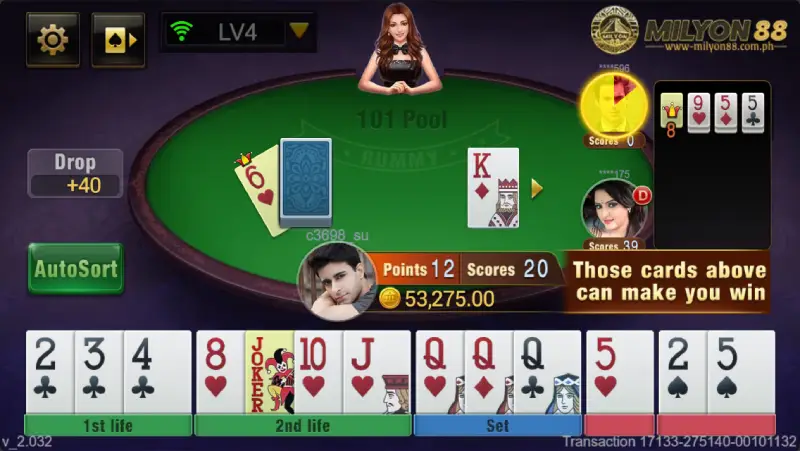With Pool Rummy you get the best of both worlds by fusing the excitement of modern-day competition with the grasp of nostalgia. It’s a thrilling variant of the classic card game that puts you against real players in high-stakes matches. Unlike the rest, it requires strategy and quick decisions as the players face the added challenge of trying to keep their points at a minimum. Understanding the unique rules, formats and tactics of the game can assist both beginners and veterans alike.

Understanding Pool Rummy Game Formats
The structured gameplay and elimination-based formats of Pool Rummy enhances its appeal to competitive players. Like all games, it revolves around accruing the least points over multiple rounds. There are two main types: the 101 and 201 Pool. Each one has its own unique strategy, and knowing them all can instantly improve your performance.
The Basics of 101 and 201 Pool
In Pool Rummy, players have to pace themselves in order to not cross the set limit on points, be it 101 or 201. Anyone who surpasses either of these gets eliminated and the last standing survivor is declared the winner.
The 101 Pool is a great option for anyone looking to improve their reflexes and aggressive play, as it is much faster paced. On the other hand, the 201 Pool provides ample time for deeper and complex strategies due to its long gameplay.
Key differences include:
| Feature | 101 Pool | 201 Pool |
|---|---|---|
| Point Threshold | 101 points | 201 points |
| Gameplay Pace | Fast, high-pressure | Slower, strategic |
| Ideal For | Beginners, quick games | Experienced players |
Understanding these formats will help you customize your approach be it focusing on speed or taking your time with long-term strategies.
Why Pool Rummy Appeals to Competitive Players
In comparison to Points Rummy or Deals Rummy, Pool Rummy does not offer players the opportunity to depend on luck due to its structure of focusing on aggregate performance.
The elimination mechanic introduces added friction, compelling players to adapt their strategies on the fly. Encountering real players poses a greater challenge; the element of unpredictability replaces the predictability of bots.
This format punishes over-planning while rewarding flexible strategies, which tests one’s skill.
Common Misconceptions About Pool Rummy
Most Pool Rummy players incorrectly assume it’s a game focused solely on avoidance of high-point cards. Experienced players know better.
Ending a turn without drawing a card is strategically dropping (and it has its advantages since it incurs fewer penalty points). But waiting too long to utilize high-value cards carries the risk of being caught off-guard.
A compromise is often necessary, which is learned over time.
Play 101 or 201 Pool with Live Opponitors
Competing in Pool Rummy against real people turns the game into an exciting contest of skill. Nowadays, online services provide effortless matchmaking, allowing you to play 101 or 201 Pools with other people with equal prowess.

Finding the Right Platform for Competitive Play
Some rummy apps do not focus on fair play. Ensure the platform has:
- Verified players to deal with bot accounts.
- Entry-level stakes for novices but high-stakes tables for veterans.
- Clear ranking systems based on accurate metrics.
Like RummyCircle or Junglee Rummy, some platforms provide real experiences in Pool Rummy while maintaining stringent security measures against fraudulent activities. Always check the reviews to confirm payout guarantees and smooth withdrawal processes.
How Matchmaking Enhances Your Experience
A good matchmaking system pairs you with opponents of comparable skill, preventing those frustrating mismatches.
Algorithms Consider
- Win/loss ratios.
Average points per game.
Drop rates (the frequency of strategic exits).
This ensures balanced matches where a winning strategy rather than luck, is the deciding factor.
The Thrill of Live Opponent Dynamics
Bots cannot bluff, adapt and utilize human-level creativity when making moves, but a human opponent certainly will.
Some scenarios you may encounter are:
- Aggressive players will declare early in an attempt to intimidate others and declare for them.
- Defensive tacticians sit back and wait minimizing drops until the perfect hands arrive.
Knowing the patterns helps in distinguishing good players from great players
User-Friendly Visuals and Matchmaking System
A well-structured interface augments players’ experience during immersive Pool Rummy gameplay. It keeps players focused with captivating graphics, user-friendly interfaces, and smooth real-time interaction.

Key Features of an Ideal Rummy Interface
- Card Clarity: Displays cards in high definition with matching suits and values.
- Point Trackers: Conglomerate count for score against opponents is updated live.
- Timer Displays: Each player’s time for playing their turn is individually observed and counted down.
Such interfaces that bombard users with images while scrolling ads, complex menus, or advanced graphics on a single page clutter the screen and serve to distract rather than aid strategic concentration.
How Visual Design Affects Strategy
Lines, shapes, and color patches deliver information almost instantaneously to players. They help in making fast decisions with red colored notification showing high-risk drop zones (triangles).
Example: Before a player reaches the 100 points mark in a 101 Pool game, a “Last Chance” warning is issued, prompting as quick recalculating.
Elegant movements reveal concealing actions of switching decks and parasitic alongside intricate spearhead silhouettes decelerate.
The Role of Tutorials and Tooltips
Rummy’s Pool elaborate strategies are very assistive to first-timers via interactive tutors.
These nuances include:
- When to drop/work vs. when to play on.
- For game altering scenarios such as the Aberration being observed, mark me on needing certain cards draw, grant me authority to voice concerns to the general public.
Such features enhance depth while augmenting the learning curve.
Authentic Experience—No Bots, Only Real Players
The essence of Pool Rummy lies in competing against genuine opponents. Bots drain the thrill by following predictable algorithms, while humans bring creativity and rivalry.
How Platforms Prevent Bot Infiltration
Reputable sites use:
- CAPTCHA verifications during signup.
- Behavior analysis (e.g., detecting inhuman reaction times).
- Player reporting systems to flag suspicious accounts.
Regular audits maintain ecosystem integrity.
Psychological Aspects of Human vs. Bot Play
Real players induce:
- Psychological pressure: Opponents may chat or delay turns to unsettle you.
- Adaptive strategies: Humans adjust tactics based on your discards, unlike static bot scripts.
This unpredictability forces you to refine your own strategies dynamically, making each game a unique challenge.
Why Fair Play Matters in Competitive Rummy
A bot-free environment ensures that rankings reflect true skill, not programming loopholes.
When you climb leaderboards, you want to know your victories came from outsmarting real people—not exploiting AI weaknesses. Ethical platforms invest in anti-cheat technologies to preserve the game’s integrity.
Authoritative Tips from a Rummy Veteran
Mastering Pool Rummy requires more than memorizing rules—it demands strategic foresight and emotional control. As a top-ranked tournament player, I’ve distilled hard-earned insights to help you avoid common pitfalls and elevate your gameplay.
Managing Points Like a Pro
Points aren’t just numbers; they’re a resource to be manipulated.
- Early Game: Shed high-point cards (Aces, Kings) quickly, even if it means sacrificing potential sequences.
- Mid-Game: If nearing the threshold (e.g., 90 in 101 Pool), prioritize safe discards over completing melds.
- Endgame: Calculate opponents’ probable scores—sometimes holding a Joker to block their declaration is wiser.
Example: In 201 Pool, keeping a 10♥ instead of discarding it might save you 20 points later if an opponent declares unexpectedly.
Strategic Drop Decisions: When to Fold
Dropping isn’t surrender—it’s a tactical retreat.
- First Drop (before drawing): Costs 20 points (in most variants). Ideal if your opening hand has multiple high-value unconnected cards.
- Middle Drop (after drawing once): Costs 40 points. Use this if you suspect opponents are close to declaring.
- Never Drop Late: Beyond two draws, the penalty outweighs potential losses from playing on.
Case Study: A player dropped early in a tournament final, preserving their score at 35 while rivals hit 80+ by overcommitting.
Reading Opponents Through Discards
Discards reveal more than what players don’t need—they hint at their hidden strategies.
- Sequential Discards (5♠, 6♠, 7♠): They’re likely building a flush or pure sequence elsewhere.
- High-Point Dumps Early: Indicates confidence in a quick declaration.
- Holding Jokers: If no Jokers appear in discards, assume opponents are hoarding them for big melds.
Pro Tip: Track discards mentally or use note-taking tools (if allowed) to spot patterns.
Emotional Discipline Under Pressure
Pool Rummy tournaments test nerves as much as skill.
- Tilt Prevention: After abad hand or a surprising loss, take deep breaths and reassess your game plan for the next round. It’s easy to let frustration cloud judgment, leading to rash decisions that could cost you dearly.
- Stay Objective: When losing, it’s tempting to shift blame onto opponents’ luck rather than evaluating your own choices. Acknowledge mistakes and strategize ways to avoid them in future games.
- Mindfulness Techniques: Incorporate short mental breaks between rounds to focus on breathing or visualization techniques. Imagine executing perfect hands or winning critical moments to build confidence.
The emotional element of gameplay can significantly influence decisions. Maintaining composure allows for clearer thinking, ultimately enhancing performance.
Conclusion
Investigating the details of how to play Pool Rummy, including the gameplay variations and primary strategies, assimilable skill sets and adaptability of the platform would propel an ordinary player to the level of an outstanding contender. Real players, effective algorithms, and seamless interfaces truly make the experience greater than the game of luck.
Effectively controlling points, optimizing drops, practicing discipline, and emotional control helps in dealing with the intricacies of the game. Put yourself in the middle of competition; think outside the box, pay close attention to other player’s plays, and get acquainted with the volume of knowledge provided by expert players.
These strategies, regardless of the outcome, will enhance the depth of this cherished game. Everyone, irrespective of skill level, should note that every new hand offers a chance to learn and revel in the delightful world of Pool Rummy.

Visit Miguel Reyes Author at Milyon88
Miguel Reyes
Author at Milyon88
Lorem ipsum..
Miguel Reyes — One of the leading authors of Milyon88 engaged in improving the user experience in the world of online gaming. With his experience and dedication, he creates interesting content that attracts readers and greatly boosts Milyon88’s reputation in the gaming field.